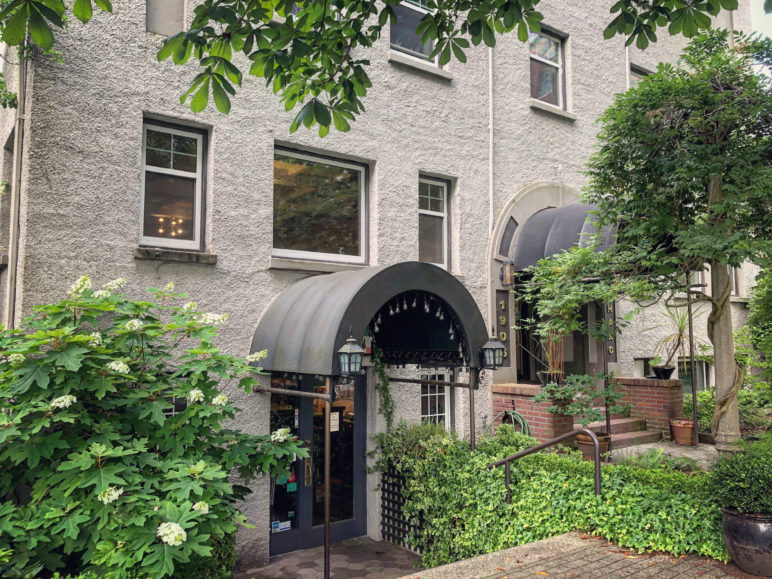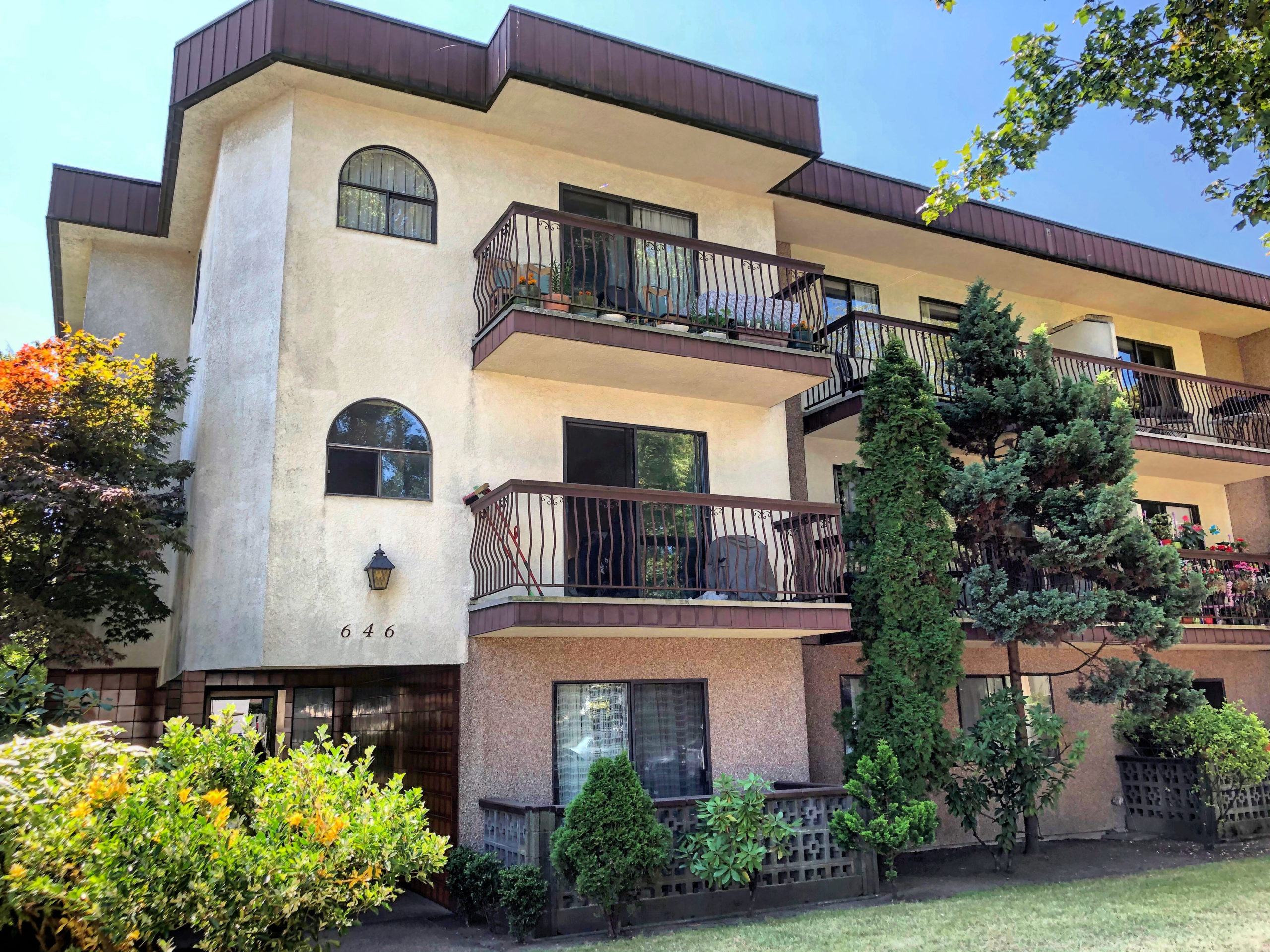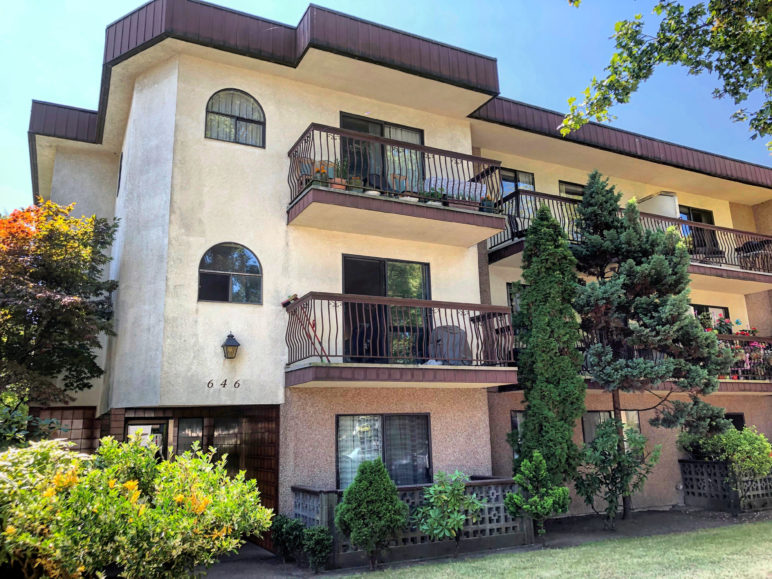The for-sale listing for a 16-unit 1984 building in Vancouver’s South Asian-dominated Fraser neighborhood is the kind that gives housing advocates nightmares—and it is mobilizing efforts to preserve older buildings to help protect affordable rentals in the region.
According to the broker’s brochure, the area enjoys a “wide range of retail amenities, supermarkets, community services, schools, restaurants, boutiques, trendy cafes and excellent bus transportation [that] characterize this vibrant community.” But the brochure also notes that“rental buildings are rarely available for sale in this area. There is significant upside on rents on suite turnover.”
In other words, the new owner of this building with almost unheard-of low rents––Can$770 for a studio and Can$991 for a two-bedroom––can skirt the province’s rules limiting rent increases; every time a new tenant replaces an old one, the owner can raise the rent to whatever the market will bear.
According to the most recent national rental-market report, the region’s average market-rate rent is Can$1,469, kept aloft by Vancouver’s rental vacancy rate, which has hovered barely above zero for years.
On top of that, if the new owner can convince regulators that the entire building needs an extensive renovation, the owner can evict all the tenants and hike rents once the renovations are complete. Provincial tenant laws do not require landlords to mitigate tenants’ moving costs or to offer tenants their renovated units at their former rate.
In the last decade, this dynamic has contributed to a huge loss of private-market, low-cost housing throughout Canada. Between 2011 and 2016, 322,600 apartments with monthly rents of Can$750 or less have disappeared, either because their rents were raised or because the buildings were demolished to make way for something newer and more expensive. In BC alone, 34,000 apartments have met this fate, according to a report by housing policy consultant and Carleton University researcher Steve Pomeroy and the BC Non-Profit Housing Association.
For veteran observers of the housing scene, it means that even with a relatively housing-forward federal government like Canada’s current Liberals, subsidized affordable housing won’t come close to keeping up with the losses in the private market. Pomeroy’s report emphasized that for every low-cost apartment complex that gets built through federal support (or occasionally, provincial support), the country loses 15 low-cost apartment units.
“These annual losses far outstrip the 150,000 new affordable units planned under the 10-year National Housing Strategy,” Pomeroy warned.
Buying instead of building
Many advocate that the solution lies in reallocating some of the subsidy for new housing to the purchase of older buildings and keep their rents low. It’s a challenging mandate for governments (which typically work very slowly), as they would have to compete with fast moving private investors, including real-estate investment trusts (REITs) and other types of institutional investors, as well as private individuals. But this solution has the potential to save many buildings from being acquired and then either upgraded to more expensive rentals or replaced outright.
Canadian Housing and Renewal Association (CHRA), along with the Federation of Canadian Municipalities, recently submitted a brief to the federal government, advocating for the acquisition strategy.
“We’re seeing this increasing financialization of rentals here,” said Jeff Morrison, CHRA’s executive director. “Part of this idea is to beat them to the punch.”
A second key benefit of this solution is the cost savings. Purchasing older buildings costs less than constructing new ones. The asking price for the 16-unit building in the Fraser neighborhood is only Can$5.25 million (or Can$328,000 per unit). When BC Housing builds something new, it “typically invests an average of Can$465,000 for a modest, concrete-built, one-bedroom unit with land costs, or an average of Can$315,000 for the same unit without the land purchase factored in,” the agency noted in an email detailing costs.
On top of that, building purchases may offer future redevelopment potential that could provide even more apartments. When a housing agency buys the land, rather than just getting a long-term lease from a city, it can also anticipate redeveloping that land at some point in order to get more density and, ultimately, more units. That’s something that BC Housing’s CEO, Shayne Ramsay, said is a factor when the agency makes a purchase.
The coronavirus pandemic is catalyzing a renewed push for the preservation of older, low-cost housing because the recession has lowered prices, and because in a health crisis, it’s not safe to turn people out of their homes.

Preserving existing homes as an affordability strategy does have one major shortcoming, however: it doesn’t create any new homes. If a city has excess demand for expensive apartments, saving one low-cost existing building will only redirect pressure for renovations to other existing buildings. To help overall affordability across an entire city or region, preservation programs must be coupled with the robust construction of new homes.
A downturn is the time to pick up apartment buildings on the cheap
The coronavirus pandemic is catalyzing a renewed push for the preservation of older, low-cost housing for two reasons: (1) during a recession (which is on the horizon), properties often sell for reduced prices, and (2) policymakers, having scrambled to find temporary housing for homeless people during the height of COVID-19, are realizing that they can’t abruptly turn those people out of the hotels temporarily leased for them and send them back to the streets.
Housing advocates say now is the time to act. Like CHRA, the Co-operative Housing Federation of BC (CHF BC) has submitted a brief to the province, urging politicians to make apartment acquisitions a part of their housing strategy in the next budget.
“What everyone noticed, after the 2008 meltdown, is that the REITs cranked up their purchasing activity,” said Thom Armstrong, executive director CHF BC. “They’re poised to do it again because the prices aren’t going up and there’s cheaper money available than anyone can remember. It’s a prime time to acquire older properties and do wholesale redevelopments or refurbishments.”
Armstrong and Pomeroy note that another advantage of buying older apartments is that they can carry private mortgages (currently at rock–bottom interest rates) because they are existing investment properties. This reduces the amount of direct capital or loans that governments have to provide.

Preserving older buildings and low rent. The Buchannan Hotel in Vancouver BC, recently purchased by the provincial government to provide affordable housing. Photo by Frances Bula, used with permission.
Canada and British Columbia are stepping up on preservation
The Canadian federal government may soon get involved in this initiative. National and local housing advocates say that talks they’ve had with Ahmed Hussen, Minister of Families, Children and Social Development, indicate that the federal government is considering changing its traditional rules to allow nonprofits to buy older buildings instead of limiting them to building new ones. With these changes, nonprofits wouldn’t have to depend on the government to handle the purchasing process. But Canada Mortgage and Housing Corporation would need to develop a quick-response system that would provide almost instant money for nonprofits trying to compete against private investors in the marketplace.
BC is already at work on acquisitions. In May, June, and July 2020, BC’s left-leaning government spent Can$120 million on 12 small hotels, motels, or rooming houses—752 rooms total—scattered around the province, including three buildings in Vancouver, two in Victoria, and two others in more northern cities. These properties will be turned over to nonprofits to run, with the province typically covering upgrade costs.
“Existing housing is the easiest form of housing,” said Selina Robinson, BC’s Minister of Municipal Affairs and Housing. “They’re in the right place, close to buses and services. But they also have development potential.
Cities are also starting to join in on the idea. Two weeks ago, City of Toronto staff put out a report suggesting the city, which is directly responsible for social housing in that province, start buying existing housing (and even office buildings) to make a dent in its homelessness problem. This week, Vancouver Mayor Kennedy Stewart put forward a proposal, still to be voted on by the rest of council, that the city come up with an aggressive strategy to buy existing hotels or rooming houses as part of the solution to the problem of encampments in parks, which are generating increasing numbers of complaints from nearby residents.
Critics claim that the province may have paid too much for some of its recent purchases. But Ramsay said the prices are justified when you factor in that cities typically allow higher density for below-market rentals, since any future redevelopment will likely yield more units than a private developer could build.
The idea of buying older buildings to protect them for subsidized housing is not new to the province. In the lead-up to the 2010 Winter Olympics in Vancouver, wanting to avoid the bad publicity that might erupt if the city’s poorest residents were suddenly displaced from their cheap downtown-adjacent hotels, bought 15 residential hotels in the Downtown Eastside, adding nearly 1,000 affordable homes to the BC’s social-housing portfolio.
Purchase and preservation efforts elsewhere in Cascadia
The movement to preserve what’s known as naturally occurring affordable housing (detached houses and apartment buildings) is growing in many American cities as well, using a range of strategies.
In Portland, Oregon, a 2016 housing bond has enabled the city to ramp up purchasing existing buildings. “The most recent example is the Ellington Apartments, which [the city] acquired using Portland Housing Bond resources to preserve 263 units of affordable housing,” said Martha Calhoon, Portland Housing Bureau’s communications manager.
Metro, the Portland area’s regional government, has a transportation bond measure going to voters this November that, if approved, will provide another pool of money for some site acquisitions along a future light-rail line in the city’s southwest quadrant. The bond could spur additional funding streams, such as tax-increment financing, to finance conversions of below-market units into private affordable housing developments. Metro’s strategy comes after concerns were raised three years ago that the construction of a new light-rail line would lead to gentrification and a loss of affordable apartments to investors looking to upgrade the buildings and charge higher rents.
Sarah Stevenson, executive director of Innovative Housing, Inc. (IHI), in Portland, said that the nonprofit has acquired the occasional small hotel or apartment building over the years—often older downtown residential hotels. In 2011 IHI opened the Clifford Apartments, a 1911 building the organization bought and improved, preserving 83 existing units and adding five more. In 2019 IHI opened the Mann House in the Laurelhurst neighborhood, with 80 apartments. These projects were funded with a combination of low-income and historic housing tax credits.
Last year, Washington’s King County partnered with Microsoft and King County Housing Authority to purchase three apartment complexes—a total of 1,029 units. The residents were allowed to stay and rents were stabilized to remain affordable to “middle–income” households earning between $60,000 and $120,000 per year. The partnership has funds to purchase another 2,000 rentals.
That same year, Seattle passed an ordinance requiring anyone trying to sell a multifamily building with at least one unit rented at below-market rates to notify the city so that officials can explore ways to preserve the building for affordable housing.
Across the US, initiatives have arisen to save buildings funded through the commonly used federal low-income-housing tax credit, to make sure those buildings don’t flip over to private investors who would then charge whatever the market will bear when their tax-credit agreements run out. The Network for Oregon Affordable Housing has financed 36 buildings in this situation, including the Allen Fremont Plaza in Northeast Portland, with assistance from the Oregon Housing Acquisition Fund.
In 2017 Oregon passed a bill establishing new tools to help save subsidized rentals from turning over to the private market. This year the Washington state legislature approved $10 million to preserve expiring tax-credit rentals. The funds will support the building purchases of nonprofit housing providers that commit to keeping the units affordable.
Preservation may be more favorable in Canada than in the US
But the buying-old-buildings concept isn’t always a slam dunk.
“It’s a tough thing because the [renovation and maintenance] expense of existing property tends to be as high or higher than [for] new,” said James Madden, senior director of the Pacific Northwest Market of Enterprise Community Partners Inc. Madden noted that groups in Seattle are more focused on acquiring empty land with already negotiated development rights, which recession-fearing builders may be ready to sell for the right price.
There are a couple of reasons why Canadian housing advocates and politicians might be more enamored with the idea of buying older buildings than their American counterparts are.
One is that Canada, unlike much of the US, has a gigantic sedimentary layer of low-rise apartment buildings from the 1960s and 1970s—boosted by a now-defunct tax-incentive program for investors––that would make good candidates for acquisition and renovation. They are not as rundown and problematic as some of the early-20th-century brick residential hotels or 1930s-era apartments that many agencies or governments acquired in earlier rounds.
“Most of the US rental apartment buildings are old pre-WWII buildings in ‘inner city’ neighborhoods,” said Greg Suttor, a recently retired senior researcher who focused on housing policy and supportive housing at Ontario’s Wellesley Institute. Suttor, who has studied the differences between Canadian and American housing markets, noted, “So far more of them are fixer-uppers than is the case in Canada.
He also pointed out that in the US, low-income housing tax-credits provide more funding for affordable housing construction than what is typically available in Canada, which has never had a similar program.
“The amount of subsidized new supply per capita the US does is materially greater than Canada has been doing in recent years, or will be doing under the [National Housing Strategy] unless they raise and accelerate the funding,” he said.
For Canadian nonprofits, which often struggle to cobble together multiple levels of funding from different levels of government, charities, and local community organizations over many years to get the construction of a single apartment building funded, the idea of simply buying a reasonably modern building and fixing it up seems very attractive.
“The hole around affordable housing keeps getting deeper,” says Jill Atkey, the CEO of B.C. Non-Profit Housing. “So new supply isn’t the only thing we should be focusing on.”
Frances Bula is a freelance Sightline contributor who has been covering urban issues and city politics in Vancouver, British Columbia, since 2004, with a focus on housing and homelessness. She won the Atkinson Public Policy Fellowship in Canada in 1999, allowing her to research those topics around the world for a year. She currently writes for the Globe and Mail, BCBusiness, and Vancouver magazine.
Thank you to Jade Chan for editing.
Sightline is a 501(c)3 non-profit organization and does not support, endorse, or oppose any candidate or political party.











